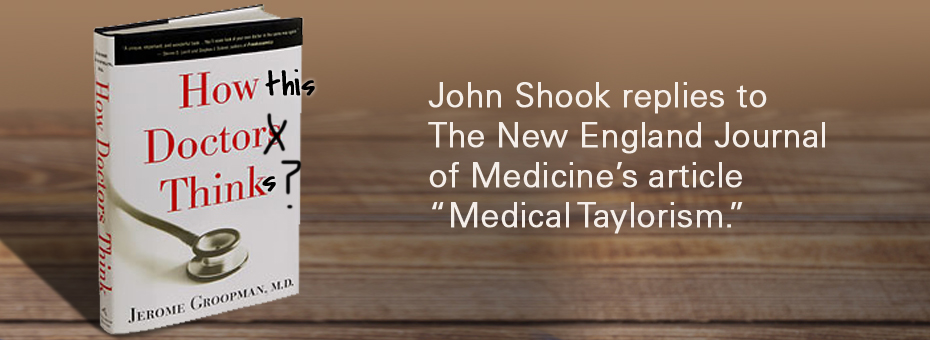Two eminent physicians wrote an article, superficial and full of misconceptions, trashing lean and Toyota in the most recent issue of the most influential journal in medicine: the New England Journal of Medicine (NEJM). I sent the following rebuttal to the NEJM; I don’t expect it to see the light of day, but here it is for your reference.
To: NEJM – Rebuttal to “Medical Taylorism” by Pamela Hartzband and Jerome Groopman
Doctors Pamela Hartzband and Jerome Groopman are renowned experts in their respective fields. I hope they practice better science on their patients than they did with their irresponsible article appearing in the January 20th edition of the NEJM. Had the authors not been so influential and the article not published to the pages of this esteemed journal, their words wouldn’t even deserve a response.
First, to quickly debunk their argument. The authors first equate Toyota methods with efficiency and then efficiency with Taylorism. Having made one false premise on top of another, the authors attack the specter of Taylorism being applied to medicine, efficiency applied to patient care.
Lean thinkers and other management scientists going back to Peter Drucker have long considered the relationship between effectiveness and efficiency. To the extent that they are distinct characteristics, healthcare, like any complex social-technical system, benefits from achieving effectiveness first, efficiency later. The Toyota methods known as lean (think of “Lean” as the generic brand, to Toyota’s proprietary brand of thinking and practice to improve organizations and work) to which the authors refer, start with building effectiveness (recall techniques from the quality movement), and, having stabilized the system, then pursue efficiency. In the real world, of course, steps and sequence are highly iterative, depending on the problem to be solved. And, in the end, efficiency without effectiveness is a nonsensical concept.
Toyota identifies two main “pillars” that define its thinking and methods: continuous improvement and respect for people. This focus on continually improving the way work is done to create value by focusing on the needs and work of the people who do the work leads to starting all improvement by clearly identifying the problem to be solved. Then, move quickly from there to the needs of the people in the system, to the work and the human doing it. And you first make it possible for the human doing the work to do it with effectiveness (properly, with required quality), and then with efficiency. That’s the evil Toyota/lean method in a nutshell. Not so evil. Certainly not, as the authors fear, single-mindedly chasing Taylorist efficiency.
(Having said that, there is an elephant in the waiting room that no one in the healthcare improvement community – where informed, thoughtful criticism is welcome – likes to discuss: the matter of cost. The US healthcare system costs twice that of almost any other system, yet does not produce better results.)
As Toyota – and others – have proven, a more effective system is a more stable system and a more stable system can indeed achieve outcomes with lower costs, made possible merely through that stability. But with stable effectiveness also come opportunities for efficiency which results in better care, lower costs, healthier patients and less-stressed providers.
So authors Hartzband and Groopman need not fear; Toyota-inspired lean experts will only pull out their stopwatches in order to diagnose the patient (the healthcare system), just as you pull out your stethoscope –to not inflict damage. Do no harm. Understand the patient. Conduct causal analysis, recommend a treatment plan to be run as an experiment, carefully observing the organization-as-patient to evaluate remedies for effectiveness. Every organization is evaluated individually, just as is every patient.
Physicians (I am not one) are notoriously defensive of any suggestion that their craft might benefit from the rigors of standards, expectations, transparency, or anything that might interfere with the physician’s discretion. Give me, as a patient, perfect care at a cost I can afford, and perhaps I will grant you the endless discretion you crave. Until then, let’s agree to let objective science carry the day: science for your work as a clinician; science for deep understanding and improvement of all the work of our healthcare providers and organizations.
The NEJM would have served both readers and the authors better by declining to print such an unworthy article. Serious debate is welcomed regarding means by which lean and other methods of “continuous improvement” are introduced effectively in healthcare. The Hartzband-Groopman article does not represent serious debate. Upon submission, the NEJM should have conferred with experienced lean practitioners, just as you would confer with experts in any discipline. Would you print an opinion piece about heart surgery that was submitted by a dermatologist without consulting the expert opinion of a cardiologist? Of course not.
Much like medicine, the practice of lean is a singularly empirical discipline. The authors have never taken part in a lean (Toyota-inspired) initiative at any level, whether small improvement activity or major organizational transformation. As they have watched from the sidelines, choosing not to get directly involved themselves, they make casual, misinformed observations, just as I might were I to observe them practice their craft in medicine. But, in this case, they diagnose and prescribe without confirming the facts of the situation, akin to prescribing treatment relying only on hearsay of the patient’s condition.
It is true that simple-minded, bone-headed applications of efficiency tools to healthcare situations are all too common. It is unfortunate that the doctors mistakenly associate these misapplications with lean thinking or Toyota. Indeed, there is much malpractice in the continuous improvement industry, with healthcare consultants peddling 12-step programs to be like Toyota.
Dr. Groopman wrote “How Doctors Think,” one of my favorite books about the healthcare profession. How disappointing that he didn’t think like a doctor when he wrote this piece.
John Shook
Chairman and CEO
Lean Enterprise Institute
Cambridge, Mass.

